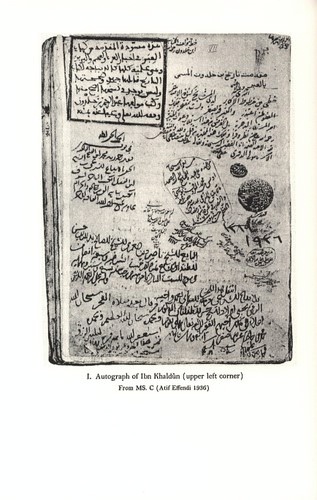The Textual History of the Muqaddimah
Manuscripts
"THE TEXT of the Muqaddimah is very well attested and documented. Few, if any, works written before modern times can boast of being as well represented by manuscripts. Four manuscripts written during Ibn Khaldûn's lifetime exist in Turkey alone. Two undated ones also exist, which were written, at the latest, shortly after his death. Manuscripts written during an author's lifetime may, of course, contain an inferior text, but in this particular case the quality of the old manuscripts is, in general, very high. One of them (A) is a copy presented to the library of the ruler of Egypt, apparently by Ibn Khaldûn himself. Another (B) was written under Ibn Khaldûn's eye by his proven amanuensis (who may also have been a friend and admirer). A third copy (C) bears testimony to its accuracy in Ibn Khaldûn's own hand.
All these manuscripts have the same textual value that, in the period after the invention of printing, would be ascribed to a book printed under its author's supervision. There may be occasional mistakes, but a carefully written manuscript usually compares favorably with a printed text. Most manuscripts of this type may be confidently regarded as authentic copies of the text, and any factual mistakes or miswritings they contain may be considered the author's own ..." (op. cit., ibid., Vol. I, p. lxxxviii)
Autograph of Ibn Khaldûn
"(4) MS. Atif Effendi 1936. The text of the Muqaddimah covers 303 folios. The manuscript breaks off with fol. 302b, corresponding to 3:413 (n. 1620), below; it is continued by another hand for a few lines, and then concludes with Ibn Khaldûn's subscription from the end of the Muqaddimah. Between fols. 129b and 130a, one quire of the manuscript has been copied in a later hand on seven additional leaves numbered 130a -136b, to replace a missing portion of the original. This situation is indicated, in Arabic, at the bottom left of fol. 129b:
"From here on, one quire is missing. We hope that God will restore it in the oriinal."
This is followed by a notation in Turkish:
"In the handwriting of the late Weysi (Wissi) Effendi,"
the famous littérateur who lived from 1561 to 1628. He purchased the manuscript in Cairo on april 7, 1598, a note on the title page informs us." (op. cit., ibid., Vol. I, p. xciii-xciv)
The First Flyleaf
"The first flyleaf of the manuscript contains the following notation:
"... I happened to read this book, the first volume of the Kitâb al-'Ibar fî akhbâr al-'Arab wa-l-'Ajam wa-l-Barbar. I have found it full of many useful notes and numerous ingenious observations. No previous (work) contains as many interesting remarks or is so rich a treasure-trove of novel, useful notes. The excellence of its composition as well as its order and arrangement show the author's perfect scholarship and his pre-eminence over his contemporaries in learning and the transmission of knowledge. I wrote these lines realizing the great importance of the book, as a testimony to its author, God give him the opportunity to enjoy it and similar (works), by (?) the Prophet and his family! These lines were written by the weak slave (of God), Muhammad b. Yûsuf b. Muhammad al-Isfijâbî, on Saturday, Sha'bân 24, 804 (April 29, 1402)."
In the upper left-hand corner of the title page appears the following note in Maghribî writing:
This is the draft of the Muqaddimah of the Kitâb al-'lbar fî akhbâr al-'Arab wa-l- 'Ajam wa-l-Barbar. The contents are altogether scientific and form a kind of artistic preface to the historical work. I have collated and corrected it. No manuscript of the Muqaddimah is more correct than this one. Written by the author of the work, 'Abd-ar-Rahmân Ibn Khaldûn, God give him success and in His kindness forgive him.
The note is framed by a gold border, the work of some later owner of the manuscript, who has also called attention to the autograph of Ibn Khaldûn in a note of his own." (op. cit., ibid., Vol. I, p. xciii-xciv)


